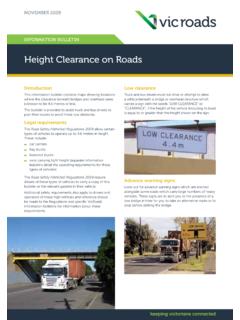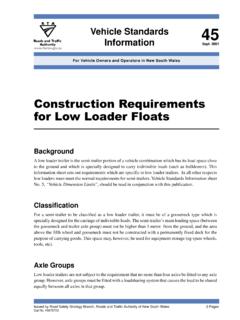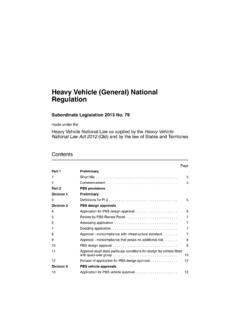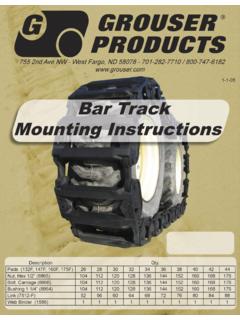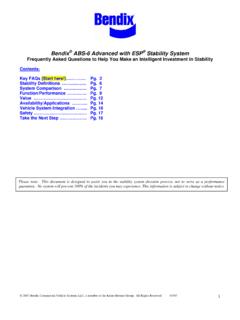Transcription of Oversize Load Carrying Vehicles - Mass Management
1 Oversize load Carrying VehiclesINFORMATION BULLETINOCTOBER 200702 Oversize load Carrying VEHICLESThis information bulletin summarises the operating conditions for Oversize and overmass Vehicles up to tonnes Carrying large indivisible items and unladen Vehicles that are specially designed to transport these items. The operating conditions enable these large Vehicles to move around Victoria in an efficient manner, without the need to obtain a VicRoads permit. The construction, earthmoving, mining, logging and primary production industries particularly benefit from this specified warning devices, operating conditions and travel time restrictions provide safe conditions for the movement of these larger Vehicles are Covered?This information bulletin applies to the following Class 1 load Carrying Vehicles :(a) a vehicle that, in Carrying a large indivisible item, exceeds one or more of the general mass and dimension limits in Part 4 of the Road Safety ( Vehicles ) Regulations 1999; or(b) an unladen low loader, step deck, drop deck or house float that is specially designed to carry a large indivisible information bulletin does not apply to:(a) a vehicle Carrying a loaded or empty container; or(b) Class 2 Vehicles , such as B-doubles and road trains.
2 Or(c) Class 3 Vehicles , such as Oversize hay Carrying are not Oversize LoadsThe Road Safety ( vehicle ) Regulations 1999 specifically exclude the transport of containers as an Oversize or overmass VicRoads Statewide Permit Group in relation to the arrangements for the transport of an indivisible item in an open top container or flat LimitsIf a load can be safely loaded in more than one way, it must be loaded in a way that minimises the width of the vehicle and its following dimension limits must not be exceeded:Table 1 - Dimension Limits for Class 1 load Carrying VehiclesType of vehicle or CombinationDimensionLimitAny vehicle or mRigid mPrime mover and semi-trailer,extendable semi-trailer orlow loader/dolly mRear overhang (the distance from the centre of the rear axle group to the rear of the vehicle (or load )) without regard to any steerable axles in the group unless all axles in the group are steerableLesser of m or 25% of the overall length of the laden combinationNote: Any flags, lights or mirrors are disregarded when measuring the width of a Vehicles must be reduced to the smallest practicable dimensions.
3 This includes retracting extendible trailers, closing in widened trailers and disassembling trailer extension : Carrying DocumentsA copy of this Information Bulletin (or the relevant Victoria Government Gazette Notice) must be carried in the driving compartment of a vehicle operating under the arrangements described in this bulletin. It must be produced if requested by a VicRoads Authorised Officer or a Police load Carrying Vehicles 03 axle Mass LimitsAxle mass limits for low loaders are shown in Table 2 - axle Mass Limits for Class 1 Low LoadersNotes:m * Trucks are able to operate up to tonnes on the steer axle provided the trucks have all of the following: 1) An engine complying with the emission control requirements of ADR 80/01 (Euro 4 engine) or later version of ADR 80; 2) A front underrun protection device that complies with UN ECE Regulation No. 93; 3) A cabin that complies with UN ECE Regulation No. 29; 4) Appropriately rated tyres, axle , and suspension, to allow tonnes on the steer axle , and 5) A Gross vehicle Mass (GVM) of 15 tonnes or The axle manufacturer s mass rating and the tyre manufacturer s mass ratings must not be Mass LimitsThe vehicle gross mass limit of low loaders is the lesser of:(a) the vehicle manufacturer s Gross Combination Mass;(b) the sum of the tyre manufacturer s mass ratings for all the tyres in the combination;(c) the sum of the axle manufacturer s mass ratings for all the axles in the combination;(d) the sum of the axle mass limits from Table 2 for all axles/ axle groups in the combination; and(e) tonnes minus tonne for every of a metre by which the distance between the centreline of the rearmost axle of the prime mover and the centreline of the foremost axle of the trailer s rear axle group is less than metres (see accompanying diagrams).
4 Single axle or axle GroupNo. of Tyres per axleMass Limit (tonnes)Steer axle2 *Tandem axle group on a prime axle group on a trailer with m axle axle group on a trailer with m axle group with m axle spacings4 or tri- axle group with m axle spacings4 or axle group with m axle spacings or , , m axle spacings4 or Oversize load Carrying VEHICLESWhat Additional Safety Precautions must I take?Daytime TravelWhen travelling during daytime, Oversize Vehicles must have the warning devices shown in Table 3 - Warning Devices for Daytime TravelLocation/DaysUp to m wide and/orMore than m and not more than m wide and/or more than m and not more than m longUp to m long More than m and not more than m longPort of Melbourne RoadsNo travel restrictionsNo travel restrictionsNo travel restrictionsHume, Princes and Western FreewaysNo travel restrictionsNo travel restrictionsNo travel restrictionsRural AreasNo travel restrictionsNo travel restrictionsSunset SunriseMelbourne and Geelong Urban AreaMonday - Friday(not public holidays)No travel restrictionsNo travel am pm pmSunset pmSaturday, Sundayand public holidaysNo travel restrictionsNo travel restrictionsSunset pmIn the above table: (a) Port of Melbourne Roads means those roads south of Footscray Road servicing Swanson Dock and Appleton Dock.
5 Dock Link Road and Dockside Road, Williamstown Road west of Todd Road.(b) Melbourne and Geelong Urban Area and the Rural Area are as shown in the enclosed maps.(c) Hume Freeway means the Hume Freeway between Thomastown and NSW border, and includes the Hume Highway at Kalkallo.(d) Princes Freeway means the Princes Highway and Freeway between Officer and Traralgon and also between Laverton North and Corio.(e) Western Freeway means the Western Highway and Freeway between Deer Park and Travel When travelling at night, in addition to the requirement in Table 3, the following warning devices are required:(a) one or more warning lights, as specified, must be displayed on all Vehicles more than metres wide or more than metres long;(b) side marker lights showing yellow to the front and red to the rear and positioned no more than metres apart, must be displayed along the length of the trailer and any load . Where the load projects from the vehicle , the lights must be along the load ; (c) front clearance lights, and rear clearance lights must be attached to any load projecting out from the vehicle .
6 And(d) a pilot vehicle to accompany the Oversize vehicle where it is more than metres Time RestrictionsOversize Vehicles are not allowed to travel on the routes and during the times in Table 4 - Travel Times RestrictionsWarning DeviceMore than m wide and no greater than m wideMore m wideMore than m and not more than m longMore than m and not more than m longLow Beam Headlights onYe sYe sYe sYe sWarning Light operatingNoYe sNoNoOversize SignYes (front & rear)Yes (front & rear)NoYes (rear only)FlagsYe sYe sNoNoOVERSIZE load Carrying Vehicles 05 Travel Time Exemptions for Unladen Low Loaders and House FloatsTo allow unladen low loaders and house floats to travel to and from job sites, travel time restrictions do not apply to trailers up to 25 metres long and metres wide with 4 tyres per axle or metres wide with 8 tyres per axle . Where can I Drive?Travel is permitted on all roads, including the orange special routes (shown on the enclosed maps), except for: (a) roads in the pink Otway Area and Mountainous Area where the vehicle must not exceed metres wide and/or metres long;(b) roads in the green Gippsland Ranges Area and Colac-Surf Coast Area where the vehicle must not exceed metres wide and/or metres long;(c) on red restricted routes that are unsuitable for Oversize Vehicles ;(d) over mass limited bridges listed in Table 5;(e) on a road, bridge or structure if it would exceed any sign posted mass or dimension limit;(f) beneath a bridge or overhead structure which carries the words LOW CLEARANCE or CLEARANCE if the height of the vehicle is equal to or greater than the clearance shown on the sign.
7 Or(g) beneath any other overhead structures, bridges, cables, wires or trees unless there is at least 200 mm clearance to the highest point of the BridgesWhere it is reasonable, overmass low loaders must avoid being on a bridge at the same time as a B-double, another overmass low loader or a mobile over the West Gate BridgeIf a low loader exceeds the General Mass Limits in Part 4 of the Road Safety ( Vehicles ) Regulations 1999 and is to cross the West Gate Bridge:(a) the vehicle must travel in one of the two right hand lanes nearest the centre median; and(b) if it cannot maintain a speed of at least 65 km/h travelling over the bridge - (i) two rotating yellow warning lights must be affixed to the rear of the vehicle ; or (ii) a pilot vehicle must travel at the rear of the permit vehicle within a distance of 50 loaders exceeding General Mass Limits have specific requirements when crossing the West Gate BridgeProhibited BridgesOvermass low loaders, exceeding the general mass limits in Part 4 of the Road Safety ( Vehicles ) Regulations 1999, must not cross the bridges listed in Table 5 on page 13 of this in City of MelbourneThe registered operator must obtain permission from the City of Melbourne before the vehicle travels in the area of the City of Melbourne bounded by and including Spring Street, Victoria Street, Peel Street, Dudley Street, Spencer Street and Flinders on TollwaysUpon receipt of a permit, as soon as practical, contact CityLink on Tel: (03) 9674 2001 or Fax: (03) 9674 2060 to advise if of the intended movement and obtain a reference number.
8 Secondly, at least 30 minutes before travelling on CityLink (the Southern Link, Western Link or Batman Avenue) telephone CityLink on (03) 9674 2001 to confirm the intended travel and to obtain advice on traffic conditions, any road works and lane closures. Similarly, once Eastlink is operational, contact will need to be made with it for traffic Rail and Tram TracksThe registered operator must obtain permission from the Traffic Services Unit of the Department of Infrastructure (Tel: 1800 660 432) if the vehicle exceeds - (a) metres wide and is to cross a railway track, and/or (b) metres wide or metres high and is to cross a tramway track. Oversize load Carrying Vehicles 0506 Oversize load Carrying VEHICLESOVERSIZE load Carrying Vehicles 0708 Oversize load Carrying VEHICLESOVERSIZE load Carrying Vehicles 09010 Oversize load Carrying VEHICLESOVERSIZE load Carrying Vehicles 011012 Oversize load Carrying VEHICLESPRINCES PRINCES Oversize load Carrying Vehicles 013 NumberRoad NameFeature CrossedLocationsMap Reference1 Barwon Heads-Ocean Grove RoadBarwon RiverBarwon HeadsMel 497 C42 Benambra-Corryong Road Exhibition CreekNorth of Gibbo River JunctionVCSD 51 D53 Burnley-Kew (Swan Street,Wallen Road)Yarra River HawthornMel 45 A114 Burwood RoadHawthorn-Lilydale RailHawthornMel 45 A105 Bright-Tawonga RoadOvens RiverGermantownVCSD 50B56 Clunes-Creswick RoadCreswick CreekClunesVCSD 58 E67 Dargo RoadRileys (Scots)
9 CreekDargoVCSD 65 F98 Dohertys RoadOutfall SewerLaverton NorthMel 40 A129 Don RoadMyrtle CreekNorth of Launching PlaceVCSD 80 B5 10 Donnybrook RoadBarbers CreekEast of WoodstockVCSD 79 C211 Glenferrie RoadGippsland RailMalvernMel 59 B1012 Grange RoadMonash FwyBurnleyMel 2H G1213 Great Ocean RoadBrowns CreekSkenes CreekVCSD 101 D514 Great Ocean RoadPetticoat CreekSkenes CreekVCSD 101 D515 Heathcote-Kyneton RoadCampaspe RiverRedesdaleVCSD 60 A216 Heidelberg-Kinglake RoadDiamond CreekDiamond CreekMel 12 A617 High StreetGardners CreekGlen IrisMel 59 K918 High StreetMelbourne-Pakenham RailArmadaleMel 58 K719 Koo Wee Rup-Longwarry RoadNo 4 Yallock DrainBaylesVCSD 96 B420 Koo Wee Rup-Longwarry RoadYallock Outfall DrainBaylesVCSD 96 B421 Licola RoadMacalister RiverLicolaVCSD 82 B422 Licola RoadMacalister RiverCheynes BridgeVCSD 82 C623 Mckillops RoadJingallala RiverCabanandraVCSD 68 C424 Mckillops RoadLittle RiverWulgulmerangVCSD 67 F225 Mckillops RoadSnowy RiverDeddickVCSD 67 H326 Mckillops RoadUnnamed water CourseDeddick VCSD 67 J327 Mckillops RoadWulgulmerang CreekWulgulmerangVCSD 67 F328 Melbourne RoadUnnamed water courseGisborneMel 197 F929 Midland Highway Broken RiverBenallaVCSD 47 H230 Nepean HighwayBrokil CreekDromanaMel 151 C1031 Nepean HighwayMordialloc CreekMordiallocMel 92 F132 Normanby AvenueMerri CreekCoburg EastMel 30 A433 Omeo HighwayBingo Munjie CreekBingo MunjieVCSD 66 B234 Omeo HighwayCobungra RiverAnglers RestVCSD 50 J935 Orrong-Malvern Road Caulfield RailToorakMel 2M G1136 Queens Park Road Barwon River GeelongMel 451D437 Rushworth-Tatura Road Waranga Western ChannelRushworthVCSD 46 B238St.
10 Kilda StreetElwood CanalElwoodMel 67 D439 Snowy River Road Little RiverWulgulmerangVCSD 67 F240 Snowy River Road Suggan Buggan RiverSuggan BugganVCSD 52 G941 Studley Park Road Yarra BoulevardKewMel 2D F942 Talgarno Road Lake HumeBell Bridge VCSD 36 B343 Tarra Valley Road Tara CreekPicnic Bridge at Macks CreekVCSD 98 B944 Tarra Valley Road Tara CreekHennings Bridge at Macks CreekVCSD 98 B945 Tarra Valley Road Tara CreekStan Close Bridge at Macks CreekVCSD 98 B946 Tarra Valley Road Tara CreekSeltz Bridge Macks CreekVCSD 98 A947 Tyers RoadLatrobe RiverTyersVCSD 97 J448 Victoria Street Yarra River AbbotsfordMel 2H H2 49 Walhalla Road Stringers CreekPost Office Bridge at Walhalla VCSD 81 H950 Walhalla Road Stringers Creek East BranchRotunda Bridge at Walhalla VCSD 81 H951 Warburton-Woods Point RoadGoulburn RiverWoods PointVCSD 81 E352 Warburton-Woods Point Road Morning Star CreekMattlock (Woods Point)VCSD 81 E353 Wattletree Road Diamond CreekElthamMel 22 A254 Wattletree Road Gippsland RailMalvernMel 59 B9 Map Reference: VCSD - RACV VicRoads Country Street Directory (6th edition), Mel - Melway Greater Melbourne Street Directory 2007 Prohibited BridgesOvermass low loaders, exceeding the general mass limits in Part 4 of the Road Safety ( Vehicles ) Regulations 1999, must not cross the following bridges:Table 5 - Prohibited Bridges014 Oversize load Carrying VEHICLESW arning DevicesOversize SignThe warning sign must:(a) have the word Oversize in black letters on a yellow retro-reflective background conforming with Class 1 or Class 2 Australian Standard AS 1906; and(b) have the manufactur

